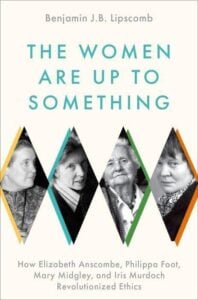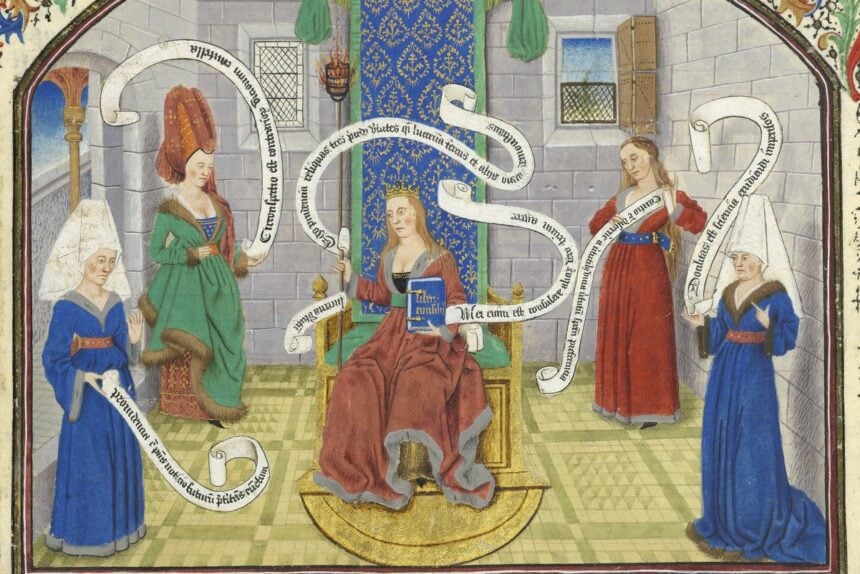
The Women Are Up To Something: How Elizabeth Anscombe, Philippa Foot, Mary Midgley, and Iris Murdoch Revolutionized Ethics
by Benjamin J. B. Lipscomb
Oxford University Press
360 pp., $27.95
St. Thomas Aquinas, following Aristotle, observed that the human person has certain inclinations that lead, when pursued, to eudaemonia—fulfillment or happiness. One of those inclinations is the use of the spiritual powers of intellect and will. Experience confirms and precision demands that when one speaks of an inclination, one acknowledges some object outside of oneself toward which one is attracted. In the case of the intellect, that object is truth; and in the case of the will, that object is the Good. Any anthropology or philosophy that does not take into rigorous account this inclination of human nature is unworthy of the name.
Concomitant with this inborn drive or, perhaps, a constitutive element of it, is an individual’s freedom. It is the interplay of the intellect and will, and the attending freedom to choose, which is the matter of examination and discussion in the science of ethics.
Ethics described in this way reflected several millennia of human reflection and philosophical insight in Western civilization. Yet such a view is in the minority among university philosophy departments today. While scholars can debate the historical location of the flashpoint for the via moderna (“modern way”) in philosophy, it might be reasonable to suggest that the period of the Enlightenment, with its exaltation of human reason and its diminution of the importance of metaphysics, was responsible for the dominant view in the 20th and 21st centuries. The Enlightenment project—especially in ethics, or moral philosophy—marched its way through the utilitarians and pragmatists of the 19th century and found its incarnation in a very particular way in the analytical philosophy of Oxford University in the early 20th century.
It is against this backdrop that Benjamin Lipscomb offers The Women are Up to Something: How Elizabeth Anscombe, Philippa Foot, Mary Midgely, and Iris Murdoch Revolutionized Ethics.
Professor Lipscomb pens a fascinating book that can be classified as an intellectual history. This term, in turn, can be understood in two ways: first, as a history of intellectual currents and developments (in this case, the ethical thought of the mid-20th century) and second, as a history of intellectuals, their lives, their influences, and their thought. Lipscomb’s protagonists are several women who attended Oxford in the 1930s and 1940s. He paints a fascinating picture of four towering intellects, whose backgrounds, tastes, and commitments were varied but who were driven by a desire for truth. It would seem an unlikely alignment: a passionate, artistic, bohemian (Murdoch); a social justice-minded aristocrat (Foot); an unpretentious mother who sought a synthesis between biology and ethics (Midgely); and a pugnacious, cigar-chewing, pants-wearing Catholic mother of seven (Anscombe). All had matriculated through Oxford and become friends through shared intellectual interests.
Philosophy in the Oxford of the 1930s and 1940s was dominated by Alfred Jules Ayer and his colleagues, who took “their stand against the spirit of ‘metaphysics’” and embraced “the opposite spirit of enlightenment and anti-metaphysical factual research.” The project in which they engaged was a linguistic analysis seeking the purification of language that could in any way be considered subjective. This endeavor created a dichotomy between facts and values. In such a framework, statements about morality are nonsensical. According to Ayer and his school, “moral judgments either praise or blame; they neither report or predict anything.” In other words, morality is merely a human projection onto a value-free reality.
The quick dismissal of several millennia of thought on the nature of things and of human acts was all the rage in the Oxford of that time period. Oxford philosopher Richard Hare built upon Ayer and held that morality had no objective content; instead, consistency with one’s convictions—whatever they were—was the only thing that mattered. In the analytical philosophy of Oxford, one’s commission of crime or avoidance thereof seemed to be a matter of taste or preference. But then something happened that Oxford philosophy seemed ill-equipped to handle: the horrors of Bergen-Belsen. Philippa Foot, upon seeing the tortured human beings of the Nazi death camp, wanted to say that it was wicked, objectively wicked. Oxford did not have the philosophical tools to deal with this in a satisfactory manner.
What Foot, Anscombe, Murdoch, and Midgely were up to in the next 40 years was to challenge the reigning orthodoxies of the Oxford dons and to provide a sound basis for ethical thinking. What they were up to was a return to Aristotle and classical and medieval approaches to a philosophy of human action. Each of the philosophers was doing something very new while critically evaluating and embracing the true insights of those that came before. Lipscomb neatly summarizes their position:
Murdoch called the fact-value dichotomy into question. Anscombe and Foot undercut Hare’s theory and urged a recovery of the concepts of vice and virtue, and what Aristotle had called eudaimonia: a flourishing life. Midgely connected this idea of human flourishing to an updated account of the animals we are.
In their philosophical analysis, the four not only challenged the Oxford establishment; they critiqued continental philosophy as well, for Sartre and the existentialists were also committed to a project that was unsatisfying, that could not answer the questions that needed answering. Each of these women was, in her own way, contra mundum.
In reading Lipscomb’s fine book, one cannot but think of the current generation of younger scholars who seem singularly unable to challenge the tenured and monolithically modernist professoriate. Indeed, with few exceptions, today’s university students and scholars seem to have embraced assumptions about structural inequality, gender and race disadvantage, and victimhood that are disproved by the work and lives of these women scholars. Indeed, nowhere more than in our current academic milieu is the insight of Iris Murdoch on full display: “Man is a creature who makes pictures of himself and then comes to resemble the picture.” Today’s academy imagines itself as woke warriors whose job it is to ensure that the world atones for past sins. In their drive for utopia, no one stops to question the assumptions under which they have operated, and any skepticism about the purity of their intention must be put down with the ruthlessness of the totalitarian. This is the picture the academy has created, and they are indeed resembling their creation.
These women, however, were the true revolutionaries, challenging a self-referential and haughty academic establishment, challenging its rather novel assumptions. For these women, the issue was truth—not power, not prestige, not acceptability. Nowhere was this more evident than in the storied career of Elizabeth Anscombe. In a memorable exchange that took place in the publication The Human World, a review of English letters, Anscombe and fellow philosophers Bernard Williams and Michael Tanner sparred over issues of religion and sex. Tanner and Williams called her arguments “offensive and absurd” and decried the “relish” with which Anscombe attacked the “spirit of the age.” Lipscomb’s recounting of Anscombe’s reply is worth quoting in full:
What, after all, is “the thought of the most serious and alive writing and theatre” of the age?: “that we are all crawling around in shit, that all is hopeless and absurd.” She concluded, “I feel mild surprise that anyone is angry with me for not much liking the spirit of the present age.”
There is no doubt that Lipscomb has made a significant contribution to the academic world with the publication of this volume. It necessarily fills a lacuna in the history of philosophy and challenges the still dominant via moderna in most philosophy departments of universities across America and Europe.
Certainly, this book is most appropriate for the philosophy student or academic, yet its many anecdotes and insights into the personal lives and decisions of these brilliant women demonstrate that philosophical movements, broad cultural currents, and life-and-death decisions are still made by real people who live real lives and who make choices in the quiet of their consciences.

Leave a Reply